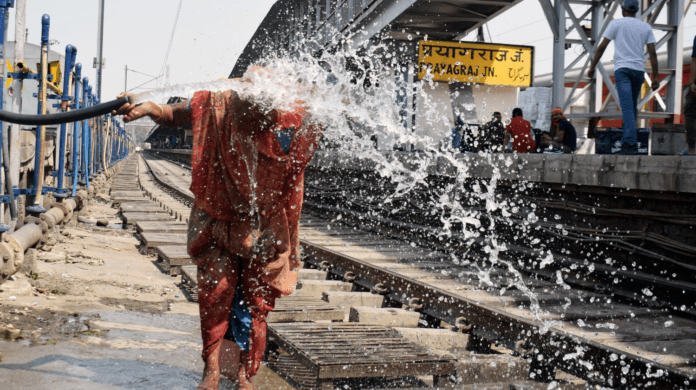Understanding and Addressing Heat Waves in India A Comprehensive Analysis.
1 min read 2024-04-24, 01:45 PM IST
|
In Short IMD Criteria: IMD declares heat waves when temperatures cross specific thresholds: 40°C in plains, 37°C in coastal areas, and 30°C in hills, with a deviation of 4.5°C for two consecutive days. New Terms: IMD introduced “warm night conditions” for elevated nighttime temperatures and “hot humid weather” for high temperatures with humidity. Impact: Heat waves affect human health, agriculture, and infrastructure, especially vulnerable groups like the elderly and outdoor workers. |
India, a land of diverse climates and landscapes, often faces the wrath of extreme heat waves during the summer months. The India Meteorological Department (IMD) plays a crucial role in monitoring and declaring heat wave conditions across the country. However, recent studies have highlighted the need for a more comprehensive approach towards understanding and addressing the impacts of heat waves, especially those that verge on humanitarian crises. This article aims to delve into the intricacies of heat waves in India, exploring the criteria for declaration, the emergence of new terms like warm night conditions and hot humid weather, and the imperative of informing and safeguarding vulnerable populations.
Understanding Heat Waves in India
Heat waves in India are primarily characterized by soaring temperatures, often exceeding the threshold set by the IMD. According to IMD guidelines, a heat wave is declared when the temperature crosses 40°C in the plains, 37°C in coastal areas, and 30°C in hilly regions. Additionally, the temperature must be above normal by at least 4.5°C for two consecutive days for a heat wave to be declared. However, when temperatures surpass 45°C, the IMD promptly declares a heat wave, irrespective of the deviation from normal temperature.
New Global Update- your speediest source for breaking news! READ NOW →
The Impact of Heat Waves
Heat waves have far-reaching impacts on various aspects of life, including human health, agriculture, and infrastructure. High temperatures can lead to heat-related illnesses such as heatstroke, dehydration, and heat exhaustion, posing a significant risk to vulnerable populations, including the elderly, children, and outdoor workers. Moreover, heat waves can adversely affect crop yields, water resources, and energy consumption, exacerbating socio-economic challenges in affected regions.(also read: Dubai Record-Breaking Rainfall Unraveling the Causes Behind UAE’s Historic Wettest Day).
New Terms Warm Night Conditions and Hot Humid Weather
In recent years, the IMD has introduced two new terms to describe specific conditions associated with heat stress: warm night conditions and hot humid weather. Warm night conditions refer to nights with elevated temperatures, which impede the body’s ability to cool down, leading to discomfort and sleep disturbances. Hot humid weather, on the other hand, combines high temperatures with high humidity levels, intensifying the heat stress experienced by individuals.
Challenges in Monitoring and Informing
Despite the IMD’s efforts to monitor and declare heat wave conditions, certain challenges persist, particularly concerning the monitoring of humid heat waves and the dissemination of information to affected populations. Studies suggest that humid heat waves, which approach the humanitarian survivability threshold of heat stress, are already occurring in India but are not adequately monitored. Moreover, there is a lack of awareness among the general public regarding the occurrence and potential risks associated with heat waves, especially among marginalized communities residing in urban slums and rural areas.
Addressing the Gap
To address the gap in monitoring and informing about heat waves, a multi-pronged approach is imperative. Firstly, there is a need for enhanced monitoring systems that can accurately detect and predict humid heat waves, taking into account both temperature and humidity levels. This could involve the deployment of advanced weather monitoring technologies and the integration of climate modeling techniques to improve forecast accuracy.(also read: Dubai Braces for Heavy Rain and Hail: Shift to Work-from-Home, Distance Learning Activated).
|
In Short Challenges: Monitoring humid heat waves and informing the public remain challenges, with a lack of awareness among the population. Addressing the Gap: Solutions include enhancing monitoring, raising public awareness, and implementing coordinated policies to mitigate heat wave impacts. By improving monitoring and awareness and implementing targeted interventions, India can better prepare for and mitigate the impacts of heat waves on its population. |
Secondly, efforts should be directed towards raising awareness about heat wave risks and protective measures, particularly among vulnerable populations. This could be achieved through community outreach programs, educational campaigns, and the dissemination of heat wave advisories through multiple channels, including media, mobile phones, and community networks.
Furthermore, there is a need for coordinated action at the policy level to address the underlying factors contributing to heat vulnerability, such as inadequate housing, lack of access to cooling facilities, and urban heat island effects. This could involve the implementation of heat action plans, building codes that prioritize heat-resilient infrastructure, and social protection measures to support those most affected by heat waves.

Heat waves pose significant challenges to public health, agriculture, and infrastructure in India, with vulnerable populations bearing the brunt of their impacts. While the IMD plays a crucial role in monitoring and declaring heat wave conditions, there is a need for a more comprehensive approach towards understanding and addressing the complexities of heat stress, including humid heat waves. By enhancing monitoring systems, raising awareness, and implementing targeted interventions, India can better prepare for and mitigate the impacts of heat waves, ensuring the well-being and resilience of its population in the face of extreme heat events.

